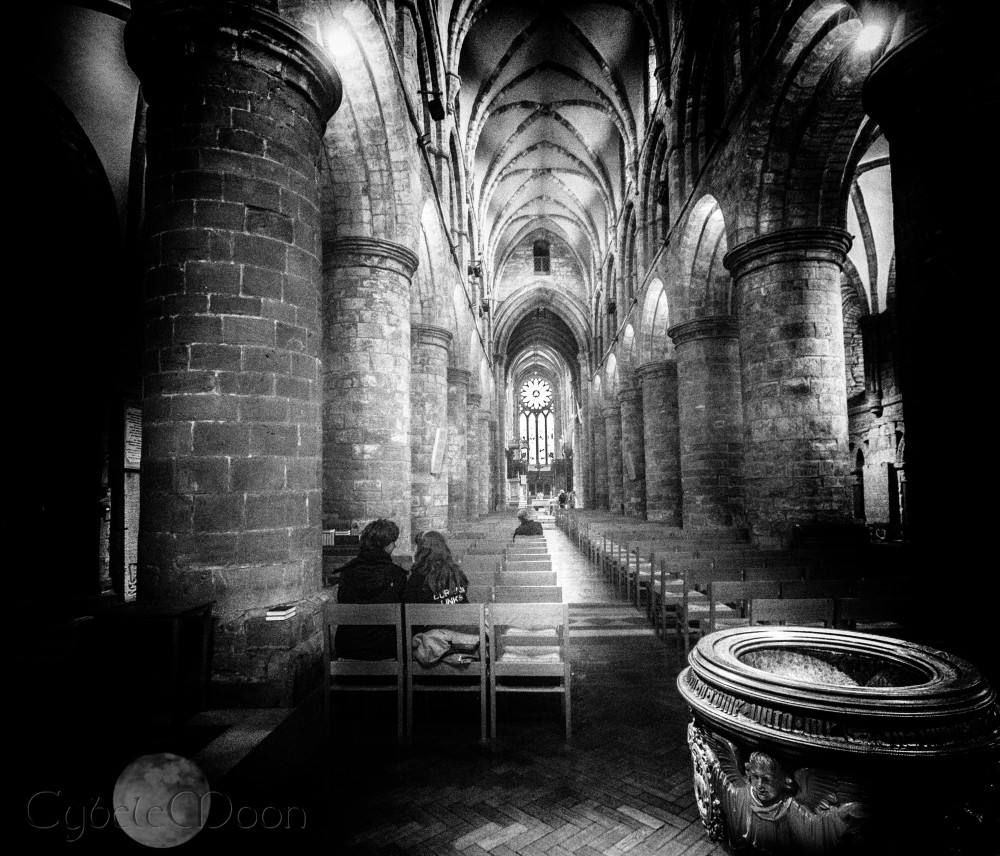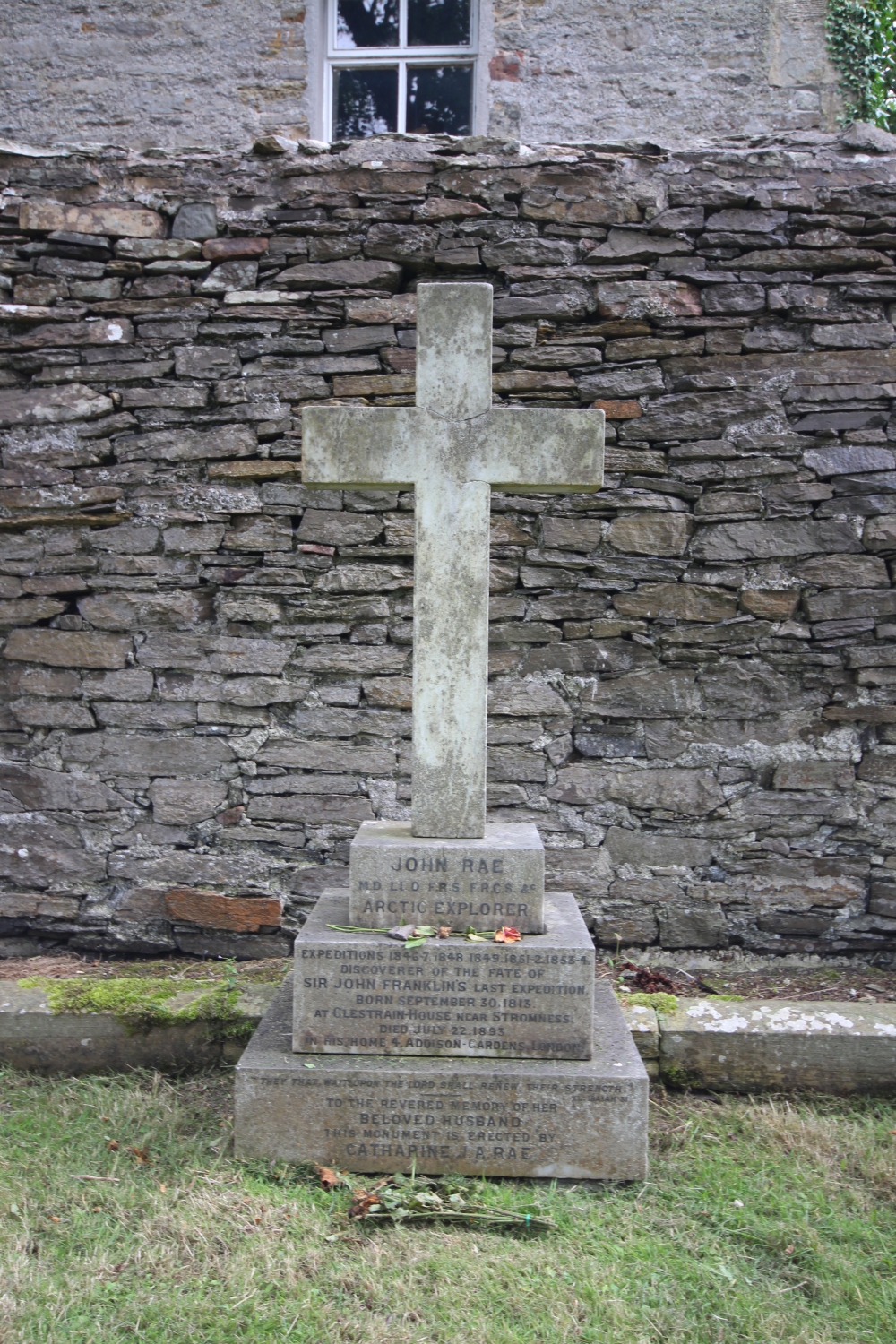Ed Mooney, the Ruin Hunter and author of Ed Mooney Photography on WordPress has got me going. He promises a ruin hunter badge. Well, we don’t have many ruins in Canada but we do have some interesting history such as that of The Governor and Company of Adventurers of England Trading into Hudson’s Bay. It was founded in 1670 as a fur trading and exploration enterprise, and now is known as “The Hudson’s Bay Company” or more succinctly “The Bay,” a very successful Canadian retail establishment.
While visiting Kirkwall in the Orkney’s, I walked between the beautiful Gothic pillars of St. Magnus, an old and historic Viking Cathedral. Originally built in 1137 it is named after a martyred Norse earl, Magnus Erlendsson who had converted to Christianity.


At the end of the center aisle I found a great surprise and one I’m ashamed to say, I had not read or heard about in my history books during school days. In a shadowed corner to the side of the main sanctuary there rests a man in leather and furs with a rifle and a book beside him. Tired from his endeavours he has fallen peacefully asleep.
It is John Rae, not a saint but rather an unsung hero, and another intrepid Scottish explorer of the “new world.” He was born in the Orkneys, near Stromness, studied medicine in Edinburgh, and in 1836 joined the Hudson’s Bay Company of Adventurers exploring the northernmost regions of Canada. Rae, became one of the first Europeans to winter in the arctic without a supply ship by living in the manner of the native Inuit.
In 1845 The Franklin Expedition set out to look for a Northwest Passage through the Arctic. Months became years but they never returned. Search parties were finally sent out in 1849 to no avail. In 1854 John Rae heard stories from the Inuit and with them was able to locate a few relics and some of the remains of the lost explorers, including what appeared and was later confirmed to be, cannibalized human bones. His private report to the British Admiralty on the tragic fate of the Expedition was “shocking and unwelcome.”
Rae returned to England in his later years. He was awarded the Royal Geographical Society Founder’s Gold Medal and ten thousand pounds for solving the Franklin mystery. However, he was never given the recognition he deserved, because of Lady Franklin’s effort to suppress the findings and to glorify her husband’s expedition in the public eye.
He died in London in 1893. His body was brought back home to the Orkneys and is buried in the kirkyard cemetery. His statue reads “John Rae, Arctic Explorer.”



I read that story about the expedition. Crazy.
Anyway, I like the columns of the cathedral. So vast and stalwart. The black and white enhances them. The contrast is good.
LikeLiked by 1 person
a grand cathedral and not only stone but full of wood sculpture. I’m glad you like it. Monochrome works well for it. Yes, those poor souls on that expedition!! Thanks for visiting again Peter!
LikeLiked by 1 person
Beautiful cathedral shot, Cybele – and fascinating information about John Rae. More relics of that doomed expedition have been found I think. And I was on the Orkneys 40 years back – looking for (but failing to find!) Snowy Owls. A
LikeLiked by 1 person
thanks somuch and oh I didn’t do that when I was there but saw the puffins!! We have snowy owls in Canada but further north.
LikeLiked by 1 person
Beautiful images, and interesting history. I don’t recall reading this history of Franklin or Rae.
Good luck with the Badge! I know you can do it. 🙂
LikeLiked by 1 person
I think it’s just a spiritual badge Deb! Glad you enjoyed the post!! Thank you!
LikeLiked by 1 person
Great monochrome. The first one is very nice!
LikeLiked by 1 person
a beautiful church!! Thanks Maria!
LikeLike
Amazing history and beautiful photography! 🙂
LikeLiked by 1 person
I always love the stories that go with places!!
LikeLiked by 1 person
I think that some of my Scottish ancestors travelled to Canada and had some links with the Hudson Bay Co. Will have to ask my mother, who’s really into genealogy.
The architecture of that Cathedral is wonderful — so grand and yet raw in its simplicity. The sort of place where the walls have absorbed the spirituality of its worshippers over the ages, and where spiritual things can still happen. I’m not into cosy churches. If congregations are made too comfortable, they tend to become smug and less spiritually focused.
PS That’s probably a sweeping statement based on personal experience. The only time I’ve had mystical experiences, has been in a cold and drafty church with stunning but simple architecture!
LikeLiked by 1 person
I agree with you on that Sarah except in Greece where they have these tiny Byzantine chapels by the road side – dark inside and lit by candles with icons circles inside with maybe someone inside fervently praying. I remember those well from many years ago when I was there. You should research the Hudson Bay connection if you can!!
LikeLike
Love the images
Great back story
Sheldon
LikeLiked by 1 person
thanks so much Sheldon!
LikeLike
Ah the lovely St Magnus’ Cathedral…..nice
LikeLiked by 1 person
thanks Mark- it is wonderful!
LikeLike
Very interesting! And great shots. Well done.
LikeLiked by 1 person
thank you Lizzie!
LikeLike
It’s so strange how, when one first learns something, additional mentions of the same thing seem to pop up! A fellow WordPress photographer will be traveling the Northwest Passage next year and it is from him that I first learned of the Franklin Expedition and it’s sad fate. And here, not a week later, you post about it. Thanks for sharing the story and for the wonderfully evocative images! Beautiful in monochrome, Cybele.
LikeLiked by 1 person
Synchronicity Stacy!! It happens all the time!! Thanks my friend.
LikeLiked by 1 person
Thanks for teaching me the word for it, Cybele! Hmm, wonder if the cosmos is hinting at a trip thru the passage for me??😉
LikeLiked by 1 person
Just don’t call it an expedition!!! 😀
LikeLike
😂
LikeLiked by 1 person
You are digging in History and I follow you steps Cybele.
I’ve visited Ed’s post and I was glad to see your castle there as well as the Greek Theatre in Taormina,Sicily.They still speak Greek there.
Interesting the first part of your post with the references to Hudson’s Bay,which is old-age but still n existence.
The interior photo of St Magnus Cathedral is fabulous and so is the statue of John Rae and all the history behind it.Great monochromatic work steeped in history 🙂
LikeLiked by 1 person
I am enjoying delving into some history Doda!! Glad you like it too. And yes many names were originally Greek in Italy like Naples and Calabri including many Sicilian surnames.
LikeLiked by 1 person
Thank you Cybele!Ask Nick about Magna Graecia (Μεγάλη Ἑλλάς) xxx
LikeLiked by 1 person
will do!!
LikeLiked by 1 person
Adventures like those are just extraordinary. Both the original expedition and the one of Rae. Can’t imagine braving those conditions with the equipment they had!
LikeLiked by 1 person
oh I hear you! They must have been hardy souls!! ( or else perish)
LikeLiked by 1 person
Wonderful photo processing. Youhave made the statue look so lifelike it could speak. I hope you win theaward.
LikeLiked by 1 person
the ruin hunter badge lol!! I wish we had some more ruins but BC is so new, even compared to the rest of Canada! Thanks Suzanne! a little history!
LikeLike
Yes. We don’t have ruins here either – there are tumble down sheds that almost classify but nothing over 150 years. The area wasn’t settled till the 1840s.
LikeLiked by 1 person